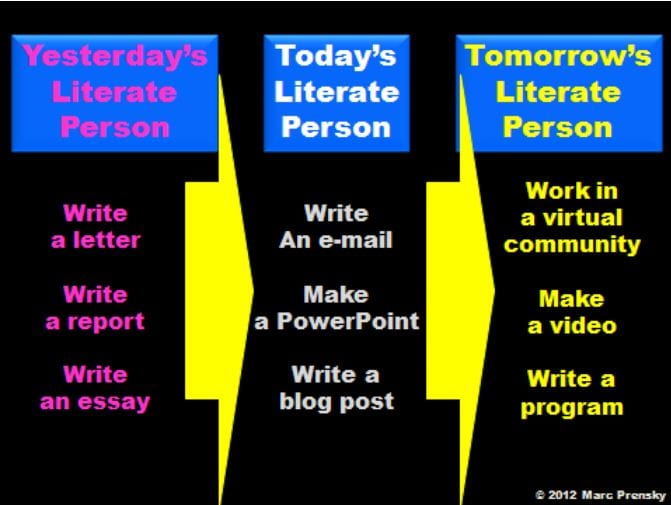Prensky’s polarisation of students and teachers into digital natives and immigrants was simplistic, but the KIS (Keep It Simple) approach can be an effective stimulant for debate. Prensky has been responsible for a lot of debate. Dig underneath the surface and the core of Prensky’s polemic remains relevant. The question of how can the social shift to digital ways of working best enhance teaching and learning remains unanswered. Prensky was right. Those with Britannica feet are being replaced by generations whose only reference source is Google. The image below is simplistic but contains a valuable message for anyone wanting to see digital literacies and scholarship embedded into the curriculum. How can an institution manage change and adapt to the digital impact of technology?
Neil Selwyn* offers a realistic appraisal of Prensky, usefully reminding us of the social shaping of technology and how usage mirrors existing social structures. The literature of digital divides should underpin all policy and strategic approaches. In the meantime digital technology is becoming more pervasive. Soon won’t need the T in ICT; it will be taken for granted. It’s ironic how the strata of digital engagement has ‘shallowness’ as the deepest and widest layer.
The key problem is the solid curriculum. It seems unable to flex enough to incorporate essential requirements for the century, namely individuals who can tell the difference between knowledge, information and personal opinion – online. The skills to manage vertical searching and differentiate between authenticity and conspiracy theories are the core basics of digital literacies, alongside the presentation of self and parameters of access. However, embedding all these into the curriculum, and focusing on digital graduate attributes, is only part of the answer.
It isn’t only about student education, it’s about teacher education too. In 2001 Prensky was saying ‘today’s students are no longer the people our educational system was designed to teach’ but a decade later no one is saying today’s education system is no longer training the teachers it needs for a digital age. Calling people natives or immigrants drew attention to digital technology for education, but as well as redesigning the curriculum for students, we need to revisit support and resources for the teachers who are implementing it, something Prensky, Selwyn and other contemporary commentators appear – so far – to have missed.
* Educating the ‘Digital Natives’ (2011) from Neil Selwyn’s Education and Technology, London: Continuum –available from Continuum (now Bloomsbury) Companion website http://www.continuumbooks.com/CompanionWebsites/book-homepage.aspx?BookId=158591

Comments are closed.